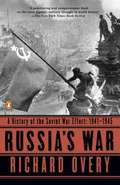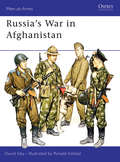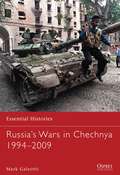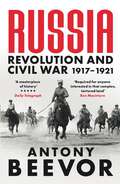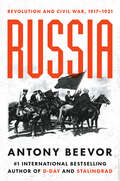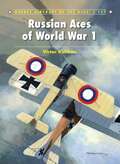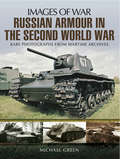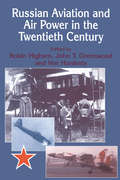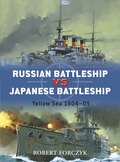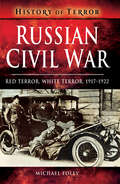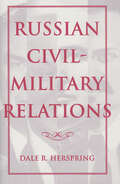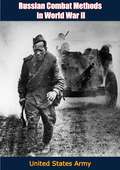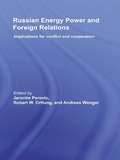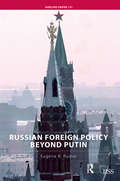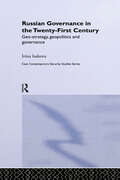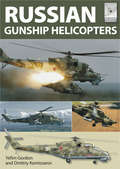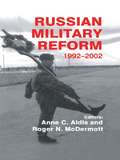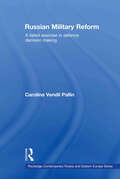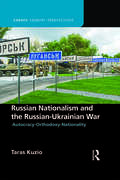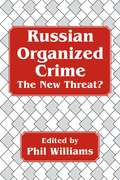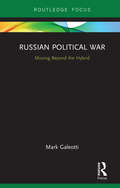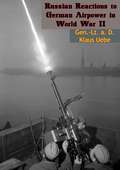- Table View
- List View
Russia's War
by Richard OveryMore information to be announced soon on this forthcoming title from Penguin USA.
Russia's War in Afghanistan
by Ronald Volstad David IsbyText by David Isby. Colour plates by Ron Volstad. This book examines Soviet forces in Afghanistan. The origins and conduct of the war and the operational organisation of Soviet forces are discussed. Afghan resistance and weaponry is also examined. A comprehensive study of both sides in the Afghan war.
Russia's War: 1941-1945
by Richard Overy"A penetrating and compassionate book on the most gigantic military struggle in world history."--The New York Times Book Review"An extraordinary tale... Overy's engrossing book provides extensive details of teh slaughter, brutality, bitterness and destruction on the massive front from the White Sea to the flank of Asia."--Chicago Tribune The Russian war effort to defeat invading Axis powers, an effort that assembled the largest military force in recorded history and that cost the lives of more than 25 million Soviet soldiers and civilians, was the decisive factor for securing an Allied victory. Now with access to the wealth of film archives and interview material from Russia used to produce the ten-hour television documentary Russia's War, Richard Overy tackles the many persuasive questions surrounding this conflict. Was Stalin a military genius? Was the defense of Mother Russia a product of something greater than numbers of tanks and planes--of something deep within the Russian soul?
Russia's Wars in Chechnya 1994-2009
by Mark GaleottiFeaturing specially drawn full-color mapping and drawing upon a wide range of sources, this succinct account explains the origins, history and consequences of Russia's wars in Chechnya, thereby shedding new light on the history - and prospects - of that troubled region.Mark Galeotti, an expert on the conflict, traces the progress of the wars, from the initial Russian advance through to urban battles such as Grozny, and the prolonged guerrilla warfare based in the mountainous regions that is common to both wars. He assesses how the wars have torn apart the fabric of Chechen society and their impact on Russia itself, where they have influenced presidential elections and widened the gulf between the military and the rest of society. These were savage conflicts which combined at different times the characteristics of an imperial war, a civil war and a terrorist campaign. The rich tradition of banditry in Chechnya, exemplified by the disproportionately large numbers of Chechens in the Spetsnaz special forces, gave the conflict its particular character, as did the steady shift from the initial nationalism to being inspired by a wider Islamic jihad.
Russia: Revolution and Civil War 1917-1921
by Antony Beevor'The book is a masterpiece' The Spectator'A gripping narrative history of one of the most complex episodes in modern Russian history' Sunday Times'Antony Beevor's Russia is a masterpiece of history' Daily TelegraphBetween 1917 and 1921 a devastating struggle took place in Russia following the collapse of the Tsarist empire. Many regard this savage civil war as the most influential event of the modern era. An incompatible White alliance of moderate socialists and reactionary monarchists stood little chance against Trotsky's Red Army and Lenin's single-minded Communist dictatorship. Terror begat terror, which in turn led to even greater cruelty with man's inhumanity to man, woman and child. The struggle became a world war by proxy as Churchill deployed weaponry and troops from the British empire, while armed forces from the United States, France, Italy, Japan, Poland and Czechoslovakia played rival parts. Using the most up to date scholarship and archival research, Antony Beevor, author of the acclaimed international bestseller Stalingrad, assembles the complete picture in a gripping narrative that conveys the conflict through the eyes of everyone from the worker on the streets of Petrograd to the cavalry officer on the battlefield and the woman doctor in an improvised hospital.
Russia: Revolution and Civil War, 1917-1921
by Antony Beevor&“Riveting . . . There is a wealth of new information here that adds considerable texture and nuance to his story and helps to set Russia apart from previous works.&”—The Wall Street JournalAn epic new account of the conflict that reshaped Eastern Europe and set the stage for the rest of the twentieth century.Between 1917 and 1921 a devastating struggle took place in Russia following the collapse of the Tsarist empire. The doomed White alliance of moderate socialists and reactionary monarchists stood little chance against Trotsky&’s Red Army and the single-minded Communist dictatorship under Lenin. In the savage civil war that followed, terror begat terror, which in turn led to ever greater cruelty with man&’s inhumanity to man, woman and child. The struggle became a world war by proxy as Churchill deployed weaponry and troops from the British empire, while contingents from the United States, France, Italy, Japan, Poland, and Czechoslovakia played rival parts. Using the most up to date scholarship and archival research, Antony Beevor assembles the complete picture in a gripping narrative that conveys the conflict through the eyes of everyone from the worker on the streets of Petrograd to the cavalry officer on the battlefield and the doctor in an improvised hospital.
Russia: The Story of War
by Gregory CarletonOutsiders view Russia as an aggressor, but Russians see themselves as surrounded by enemies, defensively fighting off invader after invader, or called upon by history to be the savior of Europe, or Christianity, or civilization itself, often at immense cost. As Gregory Carleton shows, war is the unifying thread of Russia’s national epic.
Russian Aces of World War 1
by Harry Dempsey Victor KulikovAlthough the Russian Imperial Army Air Service consisted of no more than four BAGs (Boevaya Aviatsionniy Gruppa - battle aviation groups), each controlling three or four smaller AOIs (Aviatsionniy Otryad Istrebitelei - fighter aviation detachments) equipped with a variety of aircraft types, its fighter pilots nevertheless gave a good account of themselves. Indeed, during three years of war they claimed more than 200 Austro-Hungarian and German aircraft shot down, creating 13 aces - these elite aviators accounted for around half of the victories claimed on the Eastern Front. Pilots flew a variety of fighter types, with French Nieuport scouts and SPAD VIIs proving to be the most popular, and effective, aeroplanes to see service on this front. The exploits of these aces are detailed here, with information based on material newly sourced by the author from Russian military and private archives. Many previously unpublished photographs are used to illustrate this book, supported by full-colour profiles that reveal how striking some of the aces' fighters were in this often-forgotten theatre of World War I.
Russian Armour in the Second World War: Rare Photographs From Wartime Archives (Images of War)
by Michael GreenThis WWII pictorial history of Russia&’s tanks and armored fighting vehicles provides a vivid look at the Eastern Front through rare wartime photographs.When Hitler&’s armies advanced into Russia, it was Stalin&’s tanks and armored fighting vehicles that finally pushed them back from the outskirts of Moscow. At the Battle of Kursk in the summer of 1943, the Soviet tanks and AFVs proved their effectiveness by defeating the cream of the Panzertruppen. From that point on, the tanks and armored fighting vehicles of the Red Army continued their offensive operations until they victoriously entered Berlin in April and May of 1945. In this fascinating pictorial history, military expert Michael Green provides historical images of the full range of Russian armor as well as exterior and interior color photos of preserved and restored tanks and AFVs from the period. This latest book in the Images of War series brings to life the Red Army&’s efforts to repel Hitler's Panzer Armies.
Russian Aviation and Air Power in the Twentieth Century (Studies in Air Power #Vol. 7)
by Von Hardesty Robin Higham John T. GreenwoodIn the light of new archival material the editors take a fresh look at Russian aviation in the twentieth century. Presenting a comprehensive view of Russian aviation, from its genesis in the late czarist period to the present era, the approach is essentially chronological with a major emphasis on the evolution of military aviation. The contributions are diverse, with appropriate attention to civilian and institutional themes.
Russian Battleship vs Japanese Battleship
by Howard Gerrard Robert Forczyk Ian PalmerThe first major clash between a European and Asian state in the modern era signalled the beginning of Japan's rise as a major power on the world stage. What began as differing expansionist interests in Manchuria and Korea developed into a full-blown war in 1904, with an unexpected outcome. Watched by the rest of the world's superpowers, this incredibly violent war was disastrous for the Russians who, despite their superior numbers, were defeated by the Japanese underdogs in a spectacular fashion. Japan won major victories against the Russians including the critical naval battle of Tsushima in May 1905 which saw almost the entire Russian fleet sunk, captured or interned. This was the first and last encounter of pre-dreadnought battleships and it was a huge success for Japanese tactics, skill and planning. This book discusses the design and development of the pre-dreadnoughts that would ultimately lead to a new wave of battleships. The key technical elements of firepower, protection, maneuverability and communications for each side are covered in detail and accompanied by first-hand accounts and specially commissioned artwork to explain and illustrate this historically significant duel.
Russian Civil War: Red Terror, White Terror, 1917–1922 (History of Terror)
by Michael FoleyThis historical study examines how the Bolshevik Revolution and Russian Civil War influenced events on the world stage in the Great War and beyond.The Russian Revolution of 1917 is remembered as the catalyst for a bloody conflict between the Communist Red Army and the anti-Communist White Army. But in reality, the conflict was far more complex and multifaceted, involving forces from outside Russia. In this probing history, Michael Foley examines the Russian Civil War in terms of its relationship to the larger conflict raging across Europe. It is an epic tale of brutal violence and political upheaval featuring a colorful cast of characters—including Tsar Nicholas II, Vladimir Lenin, Leon Trotsky, Joseph Stalin and Winston Churchill.
Russian Civil-Military Relations
by Dale R. HerspringFrom the author of Rumsfeld’s Wars, “an important addition to the bookshelf of any analyst of post-Soviet security affairs” (Slavic Review).Dale Herspring analyzes three key periods of change in civil-military relations in the Soviet Union and postcommunist Russia: the Bolshevik construction of the communist Red Army in the 1920s; the era of perestroika, when Mikhail Gorbachev attempted to implement a more benign military doctrine and force posture; and the Yeltsin era, when a new civilian and military leadership set out to restructure civil-military relations. The book concludes with a timely discussion of the relationship of the military to the current political struggle in Russia.“The history is both fascinating and timely.” —European Security“When military reform returns to its deservedly prominent place in the Russian political agenda, Herspring’s book will offer invaluable guidance.” —Mark von Hagen, American military historian
Russian Combat Methods in World War II
by United States Army“This publication was prepared by a number of German officers after the end of World War II. There were a number of these publications, and…they are all of significant importance in understanding the way in which the war was fought, particularly on the eastern front. This publication looks at the Russian method of waging war, which was not always to use the unsubtle steamroller attack. The pamphlet shows how the Russian was different in outlook to the German soldier, and the role of the Commissar. Each arm is examined in some detail, before the discussion turns to the peculiarities of Russian tactics. Winter warfare was the preferred season for war for the Russians, and the mass attacks of 1941 eventually gave way to much more scientific tank/infantry/air/artillery combined attacks, using the weight of manpower to flatten German defenders where they stood. There is also discussion of the importance of the Red Air Force in the war, and of the partisan movement, which was always a thorn in the German’s side. This publication should be read in conjunction with the Soviet Partisan Movement and Small Unit Actions (both in the German Report Series)”-Print ed.
Russian Energy Power and Foreign Relations: Implications for Conflict and Cooperation (CSS Studies in Security and International Relations)
by Andreas Wenger Robert W. Orttung Jeronim PerovicThis book examines Russia's new assertiveness and the role of energy as a key factor in shaping the country's behavior in international relations, and in building political and economic power domestically, since the 1990s. Energy transformed Russia's fortunes after its decline during the 1990s. The wealth generated from energy exports sparked economic recovery and political stabilization, and has significantly contributed to Russia's assertiveness as a great power. Energy has been a key factor in shaping Russia's foreign relations in both the Eurasian and global context. This development raises a host of questions for both Russia and the West about the stability of the Russian economy, how Russia will use the power it gains from its energy wealth, and how the West should react to Russia's new-found political weight. Given that energy is likely to remain at the top of the global political agenda for some time to come, and Russia's role as a key energy supplier to Europe is unlikely to diminish soon, this book sheds light on one of the key security concerns of the 21st century: where is Russia headed and how does energy affect the changing dynamics of Russia's relations with Europe, the US and the Asia-Pacific region. This book will be of interest to students of Russian politics, energy security, international relations and foreign policy in general. Jeronim Perovic is a senior researcher at the Center for Security Studies at ETH Zurich. Robert Orttung is a visiting scholar at the Center for Security Studies at the Swiss Federal Institute of Technology (ETH) in Zurich and a senior fellow at the Jefferson Institute. Andreas Wenger is professor of international security policy and director of the Center for Security Studies at ETH Zurich.
Russian Foreign Policy Beyond Putin (Adelphi Ser.)
by Eugene B. RumerRussia‘s resurgence as an assertive actor in the global diplomatic arena after a long period of introspection and preoccupation with domestic troubles, and the economic revival that underpins it, are among the most striking developments in international relations of recent years. But what drives Russian foreign policy at the end of the Putin era? To what extent is it shaped by Russia‘s role as a major energy supplier, and how long can the country remain anenergy superpower if indeed it is one? How might Russian foreign policy change in the years ahead? Which way will Russia, faced with the might of growing powers around it, and struggling with the fragility of its economic success and stability at home, choose to face in international relations? This Adelphi Paper examines the domestic context of contemporary Russian foreign policy and its key political, economic, military and security drivers, as well as looking at the contrasting outlook that preceded it, and at how Russia‘s international posture may adjust again in the coming years. It concludes with recommendations for Western policy makers on how to respond to Russia‘s return.
Russian Governance in the 21st Century: Geo-Strategy, Geopolitics and New Governance (Contemporary Security Studies)
by Irina IsakovaA stimulating new analysis of the dramatic systemic changes of the Russian state, principles of the governance and its foreign policy orientation. It reviews the extent of changes in Russian approaches to geopolitics and the most appropriate geopolitical development patterns that influenced the transformation of Russian foreign policies and military strategic thinking on the eve of the 21st century.
Russian Grand Strategy: Rhetoric and Reality
by Lynn E. Davis Miranda Priebe Alyssa Demus Samuel Charap Dara Massicot Clint Reach Mark Stalczynski Eugeniu HanUnderstanding Russia’s grand strategy can help U.S. decisionmakers assess the depth and nature of potential conflicts between Russia and the United States and avoid strategic surprise by better-anticipating Moscow’s actions and reactions. The authors of this report review Russia’s declared grand strategy, evaluate the extent to which Russian behavior is consistent with stated strategy, and outline implications for the United States.
Russian Gunship Helicopters
by Yefim Gordon Dmitriy KomissarovFeatures;* Profiles of iconic types such as the Mil MI-24 'Hind', the Mil-28 and the Kamov Ka-52 'Alligator'.* Summary of design histories and careers* Colour reference for paint schemes * Critical review of available kits* Over 180 colour and black and white illustrations, including 20 full colour side-views and a range of various 3-view line-drawings. With profiles of a host of exciting designs, accompanied by a descriptive narrative history of the various types, this volume combines practical information with reflective historical analysis, making for a visually rich volume providing modellers with all they need to know about the most exciting Russian Gunship helicopter designs and associated model kits.This edition deals primarily with the three principal attack helicopter types of the present-day Russian Army;The Mil MI-24 'Hind' otherwise known as 'the Flying Crocodile' has been produced in large numbers with many versions and variants produced. It has been supplied to a host of countries and seen considerable combat action in conflicts both in the Soviet Union and abroad. It still forms the backbone of army aviation in Russia and remains at the forefront of national exposure.The Mil-28 is a more contemporary type and is broadly the equivalent of the McDonnell Douglas AH-64 Apache. The Kamov Ka-52 'Alligator' NATO name 'Hokum-B' also features. This helicopter is in service with the Army and is entering service also with the Russian Navy. Well-illustrated histories and structural analyses are supplemented with detailed descriptions of the various plastic scale model kits which have been released, along with commentary concerning their accuracy and available modifications and decals. This level of detail and insight is sure to prove invaluable to a wide community of model-makers, both at home and overseas.
Russian Military Reform, 1992-2002
by Roger N. McDermott Anne C. AldisMilitary reform has featured prominently on the agenda of many countries since the end of the Cold War necessitated a re-evaluation of the strategic role of the armed forces, and nowhere more publicly than in Russia. Not since the 1920s have the Russian Armed Forces undergone such fundamental change. President Boris Yeltsin and his successor Vladimir Putin have both grappled with the issue, with varying degrees of success. An international team of experts here consider the essential features of Russian military reform in the decade since the disintegration of the USSR. Fluctuations in the purpose and priorities of the reform process are traced, as well as the many factors influencing change. Chapters analyse the development of Russia's security policy, structural reform of the services, the social impact of military service and experience of military conflict in Chechnya. Critical evaluations of the impact of social change on the Russian Armed Forces' capabilities and expectations complement the analysis of the on-going debate. Russian Military Reform, 1992-2002 will prove invaluable to all those interested in civil-military relationships and international security as well as to students of military theory and practice.
Russian Military Reform: A Failed Exercise in Defence Decision Making (Routledge Contemporary Russia and Eastern Europe Series)
by Carolina Vendil PallinThis book examines reform of the Russian military since the end of the Cold War. It explores the legacy of the Soviet era, explaining why - at the time of the fall of the Soviet Union - radical reform was long overdue in the wake of changing military technology, new economic and political realities, and the emergence of new threats and challenges. It discusses the problems encountered by Gorbachev in his attempts to promote military reform in the late 1980s, and goes on to analyse in detail the mixed fortunes of the policies of his successors, Yeltsin and Putin. It describes how the onset of war in Chechnya in 1994 provided clear evidence of the weaknesses of the Russian military in modern conflicts, and shows that although the Chechnya debacle did provide some impetus for reforms in the armed forces in 1997-98, the momentum was not continued under the Putin government. It argues that Putin’s policies of bolstering central control over all aspects of decision making has left untouched many key problems facing the Russian military, including infighting between different force structures, lack of transparency and independent scrutiny over defence spending, and absence of consensus on the main threats to Russia and optimum force posture. Moreover, it argues that in his attempts to concentrate all means of control to a corrupt and inefficient Kremlin bureaucracy, Putin has deprived himself of all alternative channels of independent scrutiny, control and oversight, thus exacerbating the problems that continue to plague the Russian military.
Russian Nationalism and the Russian-Ukrainian War (Europa Country Perspectives)
by Taras KuzioThis book is the first to provide an in-depth understanding of the 2014 crisis, Russia’s annexation of Crimea and Europe’s de facto war between Russia and Ukraine. The book provides a historical and contemporary understanding behind President Vladimir Putin Russia’s obsession with Ukraine and why Western opprobrium and sanctions have not deterred Russian military aggression. The volume provides a wealth of detail about the inability of Russia, from the time of the Tsarist Empire, throughout the era of the Union of Soviet Socialist Republics (USSR), and since the dissolution of the latter in 1991, to accept Ukraine as an independent country and Ukrainians as a people distinct and separate from Russians. The book highlights the sources of this lack of acceptance in aspects of Russian national identity. In the Soviet period, Russians principally identified themselves not with the Russian Soviet Federative Republic, but rather with the USSR as a whole. Attempts in the 1990s to forge a post-imperial Russian civic identity grounded in the newly independent Russian Federation were unpopular, and notions of a far larger Russian ‘imagined community’ came to the fore. A post-Soviet integration of Tsarist Russian great power nationalism and White Russian émigré chauvinism had already transformed and hardened Russian denial of the existence of Ukraine and Ukrainians as a people, even prior to the 2014 crises in Crimea and the Donbas. Bringing an end to both the Russian occupation of Crimea and to the broader Russian–Ukrainian conflict can be expected to meet obstacles not only from the Russian de facto President-for-life, Vladimir Putin, but also from how Russia perceives its national identity.
Russian Organized Crime (Cummings Center Series)
by Phil WilliamsFirst Published in 1997. Routledge is an imprint of Taylor & Francis, an informa company.
Russian Political War: Moving Beyond the Hybrid
by Mark GaleottiThis book cuts through the misunderstandings about Russia’s geopolitical challenge to the West, presenting this not as ‘hybrid war’ but ‘political war.’ Russia seeks to antagonise: its diplomats castigate Western ‘Russophobia’ and cultivate populist sentiment abroad, while its media sells Russia as a peaceable neighbour and a bastion of traditional social values. Its spies snoop, and even kill, and its hackers and trolls mount a 24/7 onslaught on Western systems and discourses. This is generally characterised as ‘hybrid war,’ but this is a misunderstanding of Russian strategy. Drawing extensively not just on their writings but also decades of interactions with Russian military, security and government officials, this study demonstrates that the Kremlin has updated traditional forms of non-military ‘political war’ for the modern world. Aware that the West, if united, is vastly richer and stronger, Putin is seeking to divide, and distract, in the hope it will either accept his claim to Russia’s great-power status – or at least be unable to prevent him. In the process, Russia may be foreshadowing how the very nature of war is changing: political war may be the future. This book will be of much interest to students of strategic studies, war studies, Russian politics and security studies.
Russian Reactions to German Airpower in World War II
by Gen.-Lt. a. D. Klaus UebeRussian Reactions to German Airpower in World War II, first published in 1964, Generalleutnant a. D. Klaus Uebe, and revised and edited by Mr. Harry Fletcher, is one of a series of historical studies written for the United States Air Force Historical Division by men who had been key officers in the German Air Force during World War II.The overall purpose of the series is threefold: 1) To provide the United States Air Force with a comprehensive and, insofar as possible, authoritative history of a major air force which suffered defeat in World War II; 2) to provide a history of that air force as prepared by many of its principal and responsible leader; 3) to provide a firsthand account of that air force’s unique combat in a major war with the forces of the Soviet Union. This series of studies therefore covers in large part virtually all phases of the Luftwaffe’s operations and organization, from its camouflaged origin in the Reichswehr, during the period of secret German rearmament following World War I, through its participation in the Spanish Civil War and its massive operations and final defeat in World War II.
